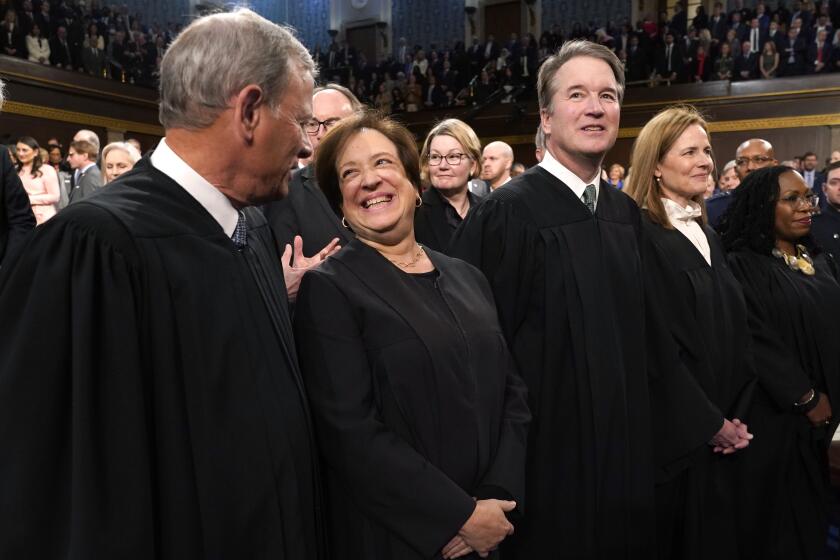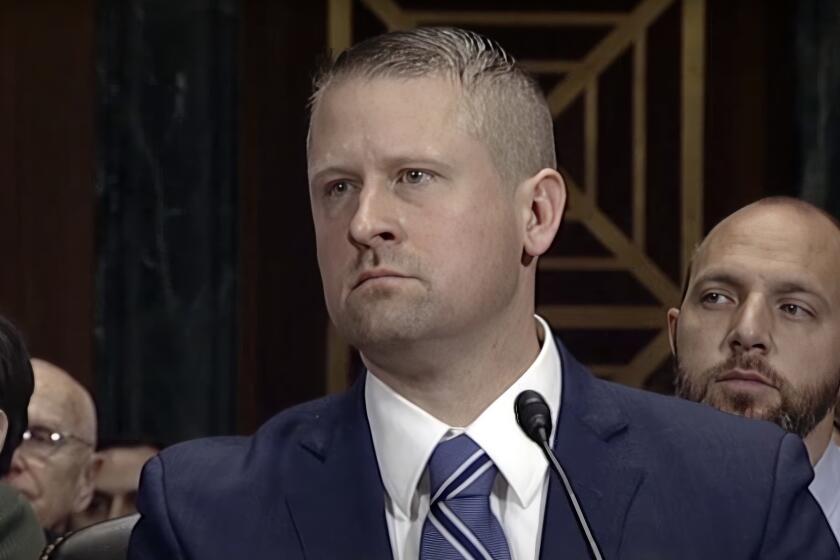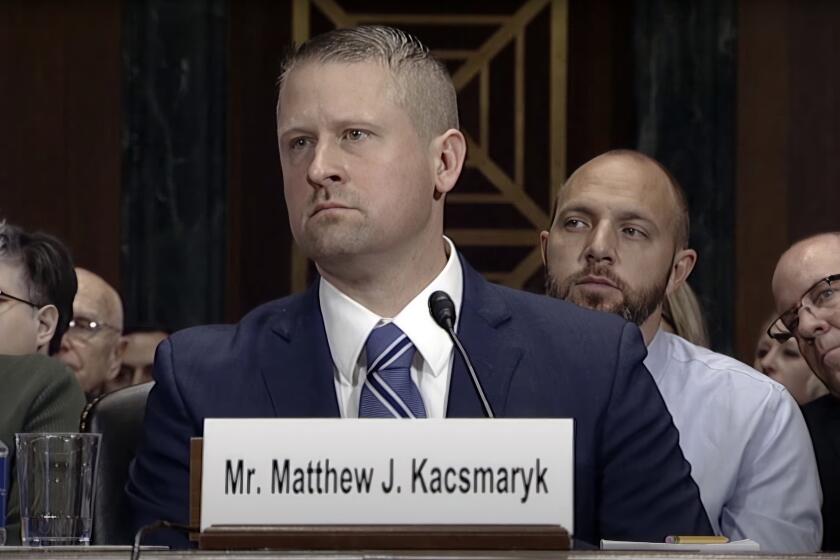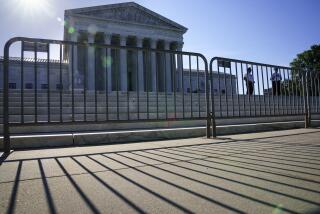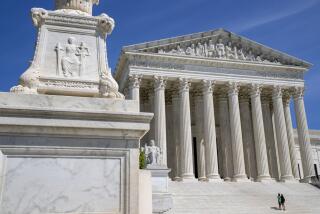Column: What FDR could advise Biden about reforming the Supreme Court — tread lightly

- Share via
If it’s true that as Mark Twain supposedly said, history doesn’t repeat itself but it often rhymes, then we are about to embark on a poetry slam for the ages, with the Supreme Court as its theme.
President Biden on Monday unveiled a package of proposals to rein in a court that has seen public confidence reach a low ebb not recorded by the Gallup Organization in readings dating back to 1973.
Most significantly, he is calling for 18-year term limits for Supreme Court justices and the imposition by Congress of binding conduct and ethics rules requiring the justices to “disclose gifts, refrain from public political activity, and recuse themselves from cases in which they or their spouses have financial or other conflicts of interest.”
Term limits would... make timing for Court nominations more predictable and less arbitrary; and reduce the chance that any single Presidency imposes undue influence for generations to come.
— President Biden on his Supreme Court reform plan
He is also proposing a constitutional amendment to neutralize a court decision appearing to give former presidents immunity for crimes committed while in office.
The template for these proposals is Franklin Roosevelt’s 1937 plan to “pack” the court by allowing presidents to appoint a new justice when any sitting justice failed to resign or retire within six months of turning 70, up to a maximum of six new justices.
Get the latest from Michael Hiltzik
Commentary on economics and more from a Pulitzer Prize winner.
You may occasionally receive promotional content from the Los Angeles Times.
The manifest goal was to dilute the influence of a cadre or conservative justices who had overruled almost every New Deal law or regulation that had come before them, as well as several other measures.
If FDR could counsel Biden today, he might warn him to move carefully; FDR’s court-packing scheme went down in flames amid congressional opposition, cut deeply into the popularity that had brought him a landslide reelection victory in the 1936 election, and brought the New Deal to a screeching halt. It also represented a moment in which FDR lost his unique ability to gauge the popular mood and act upon it.
The politics of Supreme Court reform today resemble those of 1937 in many ways, though as Twain’s supposed quip suggests, there are significant differences. Let’s look at the differences first.
Roosevelt was then at the outset of his second term, riding high on an electoral victory that may have given him a greater sense of his political omnipotence than he actually possessed. Biden, of course, is less than six months away from the end of his presidency. Roosevelt could look ahead at four more years of policymaking; Biden may be more focused on cementing his legacy of progressive achievements by bequeathing the nation a reformed Supreme Court.
After 40 years, the Supreme Court overturns its landmark ‘Chevron’ ruling, but are the implications for healthcare and environmental regulations good or bad news for businesses and consumers?
Both presidents may have felt they had nothing to lose by taking on what seemed to be the most revered of the three branches of government, albeit for different reasons — Roosevelt because nothing could chip away at his popularity, Biden because his own term in office can’t be affected by the fate of his reform proposals.
Roosevelt was faulted for springing his scheme on an unsuspecting public and Congress. Notwithstanding public discontent with the court, its reform hadn’t been an issue in the presidential campaign recently ended. FDR had not spoken publicly about the court after a series of anti-New Deal rulings in 1935 and 1936 except after one ruling in which he accused the court of relegating the country to “the horse-and-buggy definition of interstate commerce.”
Instead, he blindsided the nation by announcing his plan in a speech on Feb. 5. To his surprise, voters and legislators — including reliable New Deal supporters on Capitol Hill — reacted with fury.
It was not merely the secrecy in which the scheme had been plotted that its critics found dismaying. FDR’s stated rationale, which was that the aging justices were overworked and needed help to manage their docket, was transparently deceptive.
That rationale might have looked superficially reasonable at first, since the oldest member of the court’s so-called Four Conservative Horsemen, Willis Van Devanter, had been born during the administration of James Buchanan, which supposedly rendered him utterly out of step with the politics of the 1930s.
However, the oldest justice on the court, Louis Brandeis, was even older — at 80, he had been born during the administration of Franklin Pierce, Buchanan’s predecessor, but nevertheless was the court’s liberal lion and not an impediment to the New Deal.
Biden seems to have absorbed the lessons of FDR’s failed effort. He has been telegraphing for weeks that he is contemplating Supreme Court reforms. His proposals are not as radical as expanding the court outright, but they address some of the most evident issues driving the court’s public standing into the sub-basement: a conservative majority that has shown no respect for values and rights long cherished by most Americans, and a record of financial grifting and overt partisanship, chiefly by conservative Justices Clarence Thomas and Samuel A. Alito Jr.
Conservatives have won big legal victories by choosing right-wing judges, but the federal court system has finally gotten fed up.
As in 1937, there is a sense that the court has taken aim at progressive principles and laws, running roughshod over individual rights.
The court’s direction has been led by a conservative majority including three judges appointed by Donald Trump — among them Neil M. Gorsuch, who slid into a seat kept open by Senate Republicans’ refusal to even consider Barack Obama’s nomination of Merrick Garland to the late Antonin Scalia’s seat; and Amy Coney Barrett, rushed to confirmation by Senate Republicans in October 2020 only 38 days before the election that would unseat Trump and bring Biden to the White House.
Barrett took the seat vacated by the death of Ruth Bader Ginsburg, one of the most liberal justices ever to sit on the court.
The three Trump judges were in the majority that in 2022 overturned Roe vs. Wade, the decision that had protected women’s reproductive health rights since 1973.
It may be useful to compare the court’s behavior in recent years with what provoked FDR into launching his court-packing scheme.
The court’s distaste for elements of the New Deal was assumed as the Roosevelt administration proceeded to remake the U.S. economy. But it didn’t become palpable until it issued three decisions on May 27, 1935, a date that would become known to progressives as “Black Monday.”
In the first decision, the court overturned Roosevelt’s ouster of a reactionary member of the Federal Trade Commission, placing a limit on a president’s authority over executive officers. The court then invalidated a farm mortgage law because it applied to existing mortgages, not just new ones. Then came the court’s invalidation of the National Recovery Administration, through which the government had tried to regiment competition throughout the economy to help dig the country out of the Depression.
All three decisions were unanimous, but they still signaled that a conservative cadre was poised to undermine progressive initiatives due to come before the justices. In 1936, the court narrowed the authority of the Securities and Exchange Commission and invalidated a relief program for coal companies. Most significantly, it overturned a New York minimum wage law in a decision known as Tipaldo, after its detestable protagonist, the owner of a laundry who had been cheating his laundresses of their legal wages.
Condemnation of the Tipaldo decision came from across the entire political spectrum. “If this decision does not outrage the moral sense of the country, then nothing will,” FDR’s Interior secretary, Harold Ickes, wrote in his diary. Conservatives were dismayed that the decision undercut their argument that labor rights should remain in the hands of the states — how could that be, if the Supreme Court had overturned a state minimum wage law?
A puritan crusader got Congress to pass an anti-obscenity law in 1873. Antiabortion activists have resurrected it for their own purposes.
Roosevelt and his fellow progressives feared that the court would invalidate the entire New Deal, but FDR was confident that the public would be outraged.. For a time, FDR seemed content to let that happen, reasoning that it would help him get a constitutional amendment enacted that would allow Congress to save any law the court deemed unconstitutional by reenacting it. If the court kept overturning the New Deal, he reasoned, there would be “marching farmers and marching miners and marching workingmen throughout the land.”
In the end, he chose to go with the court-packing scheme, recognizing that it fit within the constitutional provision giving Congress the unquestioned right to dictate the size of the court.
For many Americans today, the court’s Dobbs decision overturning Roe vs. Wade has supplanted its 1857 Dred Scott decision as the worst in its history. By relegating abortion to a state-level decision, Dobbs has spawned a patchwork of punitive state laws that have life-threatening ramifications for pregnant women (among many other shortcomings).
Public distaste for Dobbs, as was the case with Tipaldo, has been manifest. Since it was handed down in June 2022, every single state initiative to protect women’s reproductive rights has prevailed at the ballot box. The chief weapons in the antiabortion camp’s quiver have been efforts to stymie referendum and initiative votes by changing the ballot box rules, as has been tried in Florida and Ohio.
Biden’s proposal to establish staggered 18-year terms for justices has several virtues. One is that it would rebalance a court on which GOP appointees are arguably overrepresented. From 1960 through this year, Republicans held the White House for 32 years and Democrats for 31, almost an even split. But in that period, Republicans have appointed 15 justices and Democrats only ten. Under Biden’s proposal, every president would have the opportunity to appoint two justices during each four-year term.
“Term limits would ... make timing for Court nominations more predictable and less arbitrary; and reduce the chance that any single Presidency imposes undue influence for generations to come,” the Biden White House says.
The one flaw in the proposal is that it could require a constitutional amendment. The Constitution states that federal justices may serve “during good behavior,” but expert opinion is divided over whether that bars Congress from imposing any other conditions on their service.
It’s worth noting that the Supreme Court was so unnerved by the groundswell of criticism it faced after Tipaldo that Chief Justice Charles Evans Hughes engineered an about-face, orchestrating a 5-4 opinion upholding a Washington state minimum wage law that was almost identical to the New York law it had overturned, also by 5 to 4. That helped to take the wind out of FDR’s scheme. The change would forever be known as “the switch in time that saved nine.” The court never overturned another New Deal initiative.
But few such opportunities for an about-face are on the horizon. The damage this court has done to individual rights and the rule of law is manifest. Biden’s sense is that the time is ripe for reform, and that this time the public may go along.
More to Read
Get the latest from Michael Hiltzik
Commentary on economics and more from a Pulitzer Prize winner.
You may occasionally receive promotional content from the Los Angeles Times.

